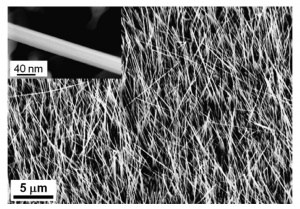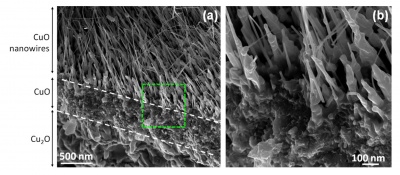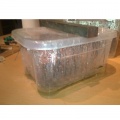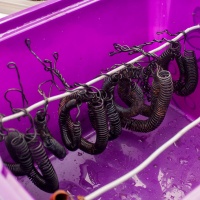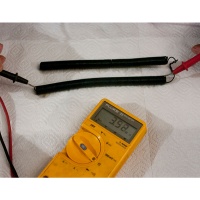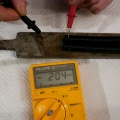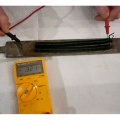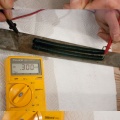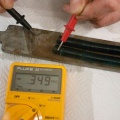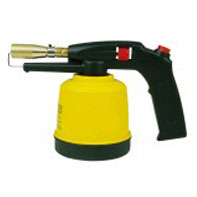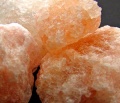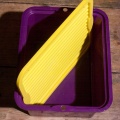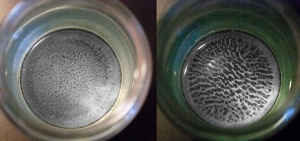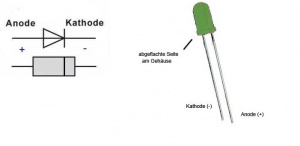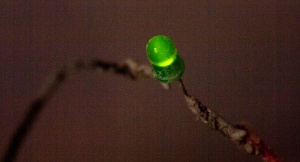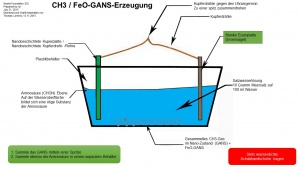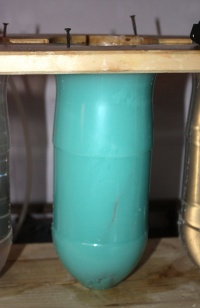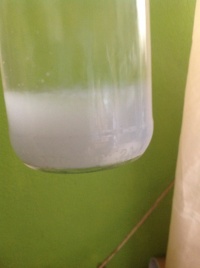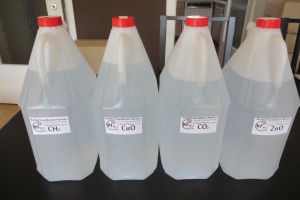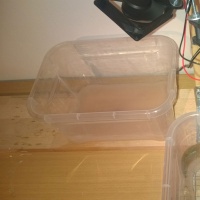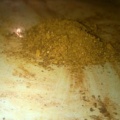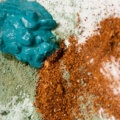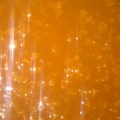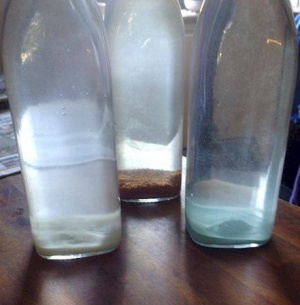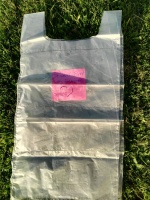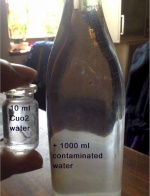Differenze tra le versioni di "KFSSI WIKI"
(→GANS in nützlichen Zuständen) |
(→Useful conditions of GANS) |
||
| Riga 249: | Riga 249: | ||
== Useful conditions of GANS == | == Useful conditions of GANS == | ||
GANS is needed in various conditions. The less water is within the GANS the more solid the substance gets, till you reach the condition of a powder. Before you get there some steps are necessary: | GANS is needed in various conditions. The less water is within the GANS the more solid the substance gets, till you reach the condition of a powder. Before you get there some steps are necessary: | ||
| − | |||
| − | |||
=== Harvesting the “amino acids” === | === Harvesting the “amino acids” === | ||
Before you are able to deal with the GANS you have to pick up the oily substance which is created during the GANS production and is floating on top of the salt water, because this substance is a valuable ingredient for a lot of applications. This oily layer obviously is a kind of organic substance. Mr. Keshe speaks about “amino acids”. What actually is created in each of the GANS containers, and which variation under which circumstances and conditions, has to be investigated in due course of time. For simplicity reasons and provisional these substances, which are created on top of the salt water of the GANS production container, are called “amino acids”, because amino acids are essential parts of the physical body of a living being. | Before you are able to deal with the GANS you have to pick up the oily substance which is created during the GANS production and is floating on top of the salt water, because this substance is a valuable ingredient for a lot of applications. This oily layer obviously is a kind of organic substance. Mr. Keshe speaks about “amino acids”. What actually is created in each of the GANS containers, and which variation under which circumstances and conditions, has to be investigated in due course of time. For simplicity reasons and provisional these substances, which are created on top of the salt water of the GANS production container, are called “amino acids”, because amino acids are essential parts of the physical body of a living being. | ||
Versione delle 08:05, 6 ott 2016
This page is under construction!
Welcome to the KFSSI WIKI pages.
Please navigate to the language you like to use:
Deutsche Version KFSSI WIKI Deutsch
Versión Española KFSSI WIKI Espanol
Indice
- 1 Introduction
- 2 Coating of copper
- 3 GANS production and application
- 3.1 CO2-GaNS
- 3.2 CH3-GaNS
- 3.3 CuO-GANS
- 3.4 ZnO-GANS
- 3.5 Useful conditions of GANS
- 3.6 Anwendung von Plasma in Notfallsituationen
- 3.6.1 GaNS-Patches
- 3.6.2 Mobile Plasma Spulen Gesundheits-Einheit
- 3.6.3 Wasserdekontaminierung
- 3.6.4 Innere und äußere Verletzungen
- 3.6.4.1 Infektionen, äußere Verletzungen, Schnittwunden, Sonnenbrand etc.
- 3.6.4.2 Innere Verletzungen (außer Kopf)
- 3.6.4.3 Knochenbrüche
- 3.6.4.4 Kopfverletzung / Gehirnverletzung
- 3.6.4.5 Desinifizierende Wirkung
- 3.6.4.6 Behandlung von Augenproblemen
- 3.6.4.7 Anwendung von GANS-Wasser in Bezug auf Viren
- 3.6.4.8 Anwendung in der Mundhygiene
- 3.6.4.9 Anwendung bei Funktionsausfall von Organen
- 3.6.4.10 Gifte aus dem Körper waschen
Introduction
Here is a collection of information and basic methods to coat copper, to produce GANS and to apply all this.
Coating of copper

The base material for the coating is copper, in any form. The coating is carried out either thermally by heating (gas burner) or chemically by etching (NaOH). During the coating "gaps between the atoms" arise and on the surface of the copper microscopic layers build up, which in turn consist of small particles that look like wires, these are also called "nano-wire" because they are so small. Therefore, the coating is often referred to as nano-coating. These nanolayers have the ability to grow during the process of the coating.
Many institutions and universities were already engaged in dealing with the thermal coating of copper. Depending on the nature of the copper at a certain temperature there appear different patterns at the surface called “graphs” or others which are called "nano-wires". For example, the scientists Yuan, Wang, Mema & Zhou (2011) [1] from the Department of Mechanical Engineering & Multidisciplinary, State University of New York have studied these nano-particles and layers in detail. The diagram shows an image of the nano-wires in the size from micrometers or nanometers (1 nanometer is 1 millionth of a millimeter: 1 / 1,000,000). The individual wires (threads) are to see clearly, standing or lying around more or less disordered. In this case the copper has been heated to 450 ° C again and again, over a period of 2 hours. It was used a copper substrate in 99.99% purity, which previously was treated with hydrochloric acid (HCI) and was washed with demineralized water, to clean the copper and to remove the natural oxide layer.
The authors affirm that the "nano-wires" during the heating process do not result out of the the so-called "grain boundaries", the cracks on the surface, but that these evolve independently. In detail, during the coating process on the surface first the copper (I) oxide layer (Cu 2 O) is formed, then a copper (II) oxide layer (CuO) comes into existence and eventually the "nano-wires" grow on the top, out of the CuO layer. Only when the CuO nano-layer is thicker than 1 micron (1 micrometer), the nano-wires begin to grow. The optimum temperature for the growth of the nano-wires is indicated with 300-550 ° C. Interestingly, as we know from the coating practice: copper (I) oxide is yellowish to reddish-brown and gets black when heated, but when it cools down it takes on its original color again. Therefore, if the coated wires are just yellowish to reddish-brown, the CuO layer was not yet formed and consequently no "nano-wires" are created. Copper (II) oxide is black, so it is important that the coated wires are black and do not have the Cu2O colors. It is therefore important to choose the right temperature for the fire coating, which we will describe in more detail at the topic of fire coating.
Furthermore, Yuan et al. (2011) have found that the surface of the nano-wires has a crystalline structure and is not hollow, each side of a nano-wire is a crystal with a clearly specified crystal lattice. In figure a and b the two sides can be seen, shown by transmission electron microscopy.
Steam-coating with NaOH
In order to coat copper wires or plates, you need:
- Plastic container with lid (not too big)
- Weights for weighing down the lid
- ready-wound copper coil, wires or plates
- ~ 100 grams of pure NaOH powder or beads (no drain cleaners; you can buy it in color shops because it is used to remove paint as alkaline-based stripper)
- ~ 2 liters of distilled water (according to the quantity of coils and size of the plastic container)
- electric kettle (water boiler) or oven to heat the water
Phase 1: NaOH-bath - cleaning the coils (~ 1 day)
At this stage it comes to cleaning the coils of fat and other substances. In a plastic container (not too big) NaOH powder is easily scattered to cover the bottom of the container, then the prepared copper coils are placed on top of the powder, they can touch each other. Next, the lid of the plastic container is obliquely placed on the container so that only a small inlet remains open. In this intake now boiling water is poured until the water covers all the coils. Caution, steam escapes, please wear protective glasses and protective gloves. Burden the lid with weights, so that not too much steam escapes, and leave the container in this state for 24 hours.
Phase 2: Steam Coating - first coating of coil (~ 2 days)
In a plastic container of the same size as in Phase 1 (it could also be the same container) a zinc grid is put at the bottom of the container, so that the coils are not directly on the plastic. Then wires are stretched on top of the container. The bottom of the container has to be covered with scattered NaOH (less than phase 1). Hang the coils, which were previously submerged in NaOH water, on the wires. The coils should have about 2 cm distance from the ground and should neither touch the container walls, nor the other coils. Next, the lid of the plastic container is obliquely placed on the container so that only a small inlet remains open. In this inlet again boiling water will be poured, but this time only about 1 cm. Close the lid as soon as possible, burden the lid with weights and wait for about 2 days. Use as in phase 1 protective glasses and protective gloves.
Phase 3: polarization of the coil (~ 1 minute / coil)
By polarizing the layers on the copper surface (coating) get excited to organize themselves, align and stabilize. Proceed as follows:
- Place the still wet coils on a nonconductive surface (wood, plastic, fabric, etc.)
- Measure with a multimeter, set on Ohms, at both ends of the coil the resistance. The coil resistance will be definitely higher than 100 kilo Ohm, usually it is in the range of Mega Ohm.
- After the operation, hang the coils back into the plastic container.
Phase 4: drying (~ 3 days) and "pull potential" (~ every 3-6 hours)
With "pull potential” the process is named where "plasma" by the power of the multimeter is encouraged to move, or to organize. In this process current is withdrawn to stimulate the system to produce new current. Proceed as follows: • Pour the bulk of the liquid from phase 2 out of the container, the coils then start with the drying process. • Remove the coil from the hanger, place them on an iron plate • Touch with the negative pole of a multimeter (set to Volt) the iron plate and then touch with the positive pole only briefly for a few seconds different points (beginning, middle and end) of the coated coils. The measured values have no meaning and vary between + and - on the display of the multimeter.
Repeat this process every 3-6 hours during the three days drying period.
Fire coating with gas burners
With this type of coating it seems to be not necessary to go through the process of polarization and drying (+ pulling potential), but the temperature and direction of the fire coating is crucial. The movement during the fire coating must always be in the direction of flow and the wires must never glow completely. Once the wires get a golden shimmer, the gas burner should be moved further.
If the wires after a few seconds of cooling down take on different colors as red, turquoise or blue throughout an area, the temperature was too low. In this case simply coat again about this passage. If the wire starts to glow, the temperature is too high, in this case simply move back the gas burner a bit (higher distance from the coil) and then start again with the coating. Over time, a sense for the fire coating will develope and everything runs automatically.
We need:
- Gas burner with butane gas (it also works with a propane / butane mixture)*
- Copper coils or plates
- Refractory mounting device for mounting /hanging) the coils or plates (preferably metallic)
Important: Do not coat in too cold rooms, otherwise very easily the coating layer separates from the copper wire; there are also differences in quality of the copper wires, sometimes slight cracks at the surface can be seen already in the "raw" state.
Please be aware to use a gas burner with a tight and narrow flame to be able to apply it very accurate (at the point), as you can see in the Video. If you use a burner which has only a wide, broad flame you will heat up the neighbouring areas too. This disturbs the needed direction of heating of each coil!
https://www.youtube.com/watch?v=gRaeT-7zIJs Video about right method of fire coating
GANS production and application
GANS is the abbreviation for "GAs in Nano-state of Solid". The Keshe Foundation has developed a method by which carbon dioxide (CO2) can be extracted from the air by simple means and converted into a solid state in the nanometer range (nano-state of solid). In the production of CO2-GANS the carbon of the air joins with the oxygen within the salt solution and within a kind of plasma bubble (consisting of Magnetical and gravitational fields) this conjunction is brought in a crystalline form. These crystals absorb the light (the fields), store and release them according to the "demand". Each crystal is like a sun!
Furthermore the Keshe Foundation discovered that this GANS, dried as well as bound in water, is useful as an energy supplier or can be usefully applied in areas of health and agriculture. The GANS-water (= the clear water above the GANS, after all of the GANS has settled, but only after the GANS was “washed” at least 5 to 10 times with distilled water – see description of GANS washing) can be used in various ways. It is possible to pour it into the bathwater, to make patches as wound dressings or to use it as a spray. Small volumes of it like some drops of it diluted in water (Liquid Plasma – see there) you can drink. The applications are almost limitless and yet only rudimentary explored.
The process of GANS-production, developed by the Keshe Foundation, does not only work for the production of CO2-GANS, but also for other kinds of "GANS". The figure shows schematically the development of GANS. The used base is "raw" copper. You can see the indicated compact atomic structure at the bottom of the graphics. In the first step the copper is nanocoated. By the coating the aforementioned gaps between the atoms are formed and nanolayers with nanowires (see Coating) come into existence. This coated copper produced in interaction with a zinc plate in salt water the CO2-GANS, which settles at the bottom.
GANS is required for the operation of the Keshe-Magravs. On the one hand the wound and coated coils are covered with GANS and on the other hand there are GANS-tanks (e.g. ping-pong ball) in the center of the coils. And GANS is required in order to produce GANS-water and this is used to produce GANS fields. These GANS-waters are used in many areas of the society. We describe here only the production of the four basic kinds of GANS, which are produced by immersion of coated copper wires or coated copper plates and various metals in 10% sea salt water (100 Gramm sea salt in 1 liter of distilled water dissolved). Thus, you need for the GANS production:
- Plastic container
- Distilled water
- unrefined, natural sea or rock salt
- coated copper wires for short-circuiting of the metals
- coated copper (plates or coils)
- metal plate uncoated, which is needed for the respective GANS production (zinc, copper, iron)
Folgende Tabelle gibt einen Überblick über die Entstehung von unterschiedlichen GaNS-Arten unter Verwendung unterschiedlicher Materialien:
| GANS | Color | Coated Material | Uncoated Material | salt content |
|---|---|---|---|---|
| Co2 (ZnO + Co2) | white | coated copper | zinc | 3-10% |
| CH3 (FeO + CH3) | reddish brown | coated copper | iron | 3-10% |
| CuO (CuO + Cu) | turquoise | coated copper | copper | 3-10% |
| ZnO | white | coated copper | zinc | 3-10% |
CO2-GaNS
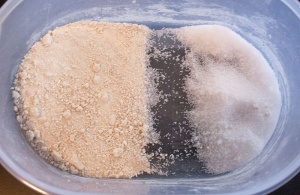
Production
This GANS is produced by dipping of zinc plates and coated copper coils or coated copper plates in saltwater. Solve 100 grams of sea salt in a liter of distilled water carefully and pour the solution into the container. Ensure that no residues of not dissolved salt come into the container. Regarding the connection of the plates or coils, there are different variants, which lead to a different CO2-/ zinc content.
CO2-/ zinc mixture in the ratio 20/80
In this case the coated copper plate / coil is directly connected to the bare zinc plate with a coated copper wire. The preparation of this mixture works very quickly, the amount of CO2-is however relatively low in respect to the zinc content.
CO2-/ zinc mixture in the ratio 90/10
In this case the two plates (nanocoated copper plate and bare zinc plate) are not directly connected with the coated copper wire, but in the middle there is a LED or the coil of a PC fan mounted. The bottom of the plates or coils should not touch the bottom of the container. Connect the anode (longer piece of wire = positive pole) of the LED with the coated plate / coil, and the cathode (notch or shorter needle on LED package = negative pole) with the zinc plate. After a few hours a white layer starts to settle on the bottom of the container, the CO2-GANS, This means: Use NO CURRENT (neither from batteries nor of power supplies) in CO2-GANS-production!!
We need:
- plastic tub/container or cut bottle
- zinc plate
- coated copper coil
- Green LED
- 100Gramm sea salt
- 1l of distilled water
Effectiveness, application
The CO2-GANS-water (depending on the application either pure or only some drops of it put into a larger volume of water) activates cells, revitalizes the body, bringing the sunlight in the body and strengthens the immune system. As a spray it immediately relieves the pain. In disasters, there are usually broken bones. Do not apply the CO2-GANS-water directly to fractures because the pain at the point of the bone fracture brings in the calcium that is needed for healing. So do not spray directly on the breaking point, but around of it. For all kinds of muscle injuries you need CO2-GANS-water.
- CO2-GANS-water can be taken in (swallowed) Eg. dropwise or 5ml to 25ml in half a liter of water - 1 to 2 times daily (according to the recommendations).
- Foot-bath: add CO2-GANS-water to lukewarm water, repeatedly applied this eliminates athlete's foot, pulls out of the body stored plasma energy of heavy metals.
- Full-bath: here you can not only apply CO2-GANS-water but also the GANS-water of ZnO / zinc, CH3 / iron and CuO / copper. For example, at Radioactive contamination Mr. Keshe recommends to take a bath with 2-3 liters of CO2-GANS-water in the bathtub with warm water and staying in this water for 2 to 3 times a day for half an hour.
- Scalp and hair: you can regularly rub with the CO2-liquid plasma scalp and hair. - It soothes the scalp, strengthens the hair root, and is supposed to bring the original hair color back.
- CO2-+ ZnO liquid plasma mixture to spray on the face: revitalizes the skin, refreshes, rejuvenates the skin.
- As aftershave lotion: alleviates possible cuts immediately and relaxes the skin.
- eczema: spray the affected skin areas with the CO2-GANS-water - very rapid improvement has been reported.
- Bee sting: sprinkle with CO2-GANS-water several times
CO2-GANS, CO2-GANS-water and the liquid plasma of CO2- is not only used in health applications but also for energy production.
CH3-GaNS
Production
This type of GANS is produced by using an iron plate and a coated copper coil dipped in sea water (or a solution of sea salt). The two metals are connected by a copper wire. Unlike the production of CO2-GANS you can use here a very low/small amount of DC current and the air of a fishtank pump to speed up the process (but this is not really necessary). Members of the Keshe foundation use i.a. a common, adjustable DC device, which produces current of approximately 15 mA between the two plates (metals), instead of the connection with a copper wire. In this case the minus pole of the device is attached to the coated metal (coated copper) and the plus pole of the device is connected to the blank, not coated iron plate. You could also use a 1,5 V battery as power source. If you use any kind of current you should in addition definitely feed air into the salt solution e.g. with a fish tank pump. After a few hours the production of a reddish brown layer at the bottom of the container starts. This is the CH3-GANS. To get a better result, as described with the CO2-GANS production, you can mount a coil of a PC-fan between the two metals (instead of a wire or a current source). We need:
- Plastic Container
- Iron plate
- Coated copper coil (or coated copper plate)
- 100 gram sea salt
- 1 liter distilled water
- Optional: DC-Device and fishtank pump
Effectiveness, application
CH3-GANS-water und Liquid plasma of CH3-GANS act strong energizing upon the body. It is also a part of the nutrition: for instance, 8 parts (drops) of GANS-water of CH3, 1 part (drop) of ZnO, 1 part (drop) of CO2. The fields of Ch3-GANS-water give the energy, those of ZnO are supporting the nervous system and those of CO2 act connecting the muscles with the nervous system. The carbon within CH3 and CO2 releases energy and the hydrogen of CH3 and the oxygen of CO2 join and provide the moisture, which is needed within the body. The energy of the H of CH3 becomes food. The ZnO/Zinc oxide supports the nerve connections which are needed to implement this energy into the body. Always add one drop of the respective amino acid (which builds on top of the salt water during the process of GANS production in each of the containers), this assures that the application is able to be effective within the body. Everytime when you want to apply CH3 as food you must add amino acids. The amino acids tell the body that the energy is provided for the body. The GANS and the amino acids are created within the same container and therefore have an inner connection regarding their inner structure. This inner connection is obviously necessary for the fields of the GANS and its information, which are available within the GANS-water and the liquid plasma, to be transferred to the molecules of the cells of a living body. The real procedures are topic of present and future research.
CH3-GANS is also necessary for technical energy production.
CuO-GANS
Production
For the production of CuO-GANS you need a blank copper coil (or copper plate) and a coated copper coil (or a coated copper plate), dipped in a sea salt solution. The two metals (plates or coils) get connected by a copper wire. To speed up the process, the same as with the GANS production of CH3, you can use here a low/small amount of DC current and the air provided by a fish tank pump. Some members of the Keshe Foundation use a DC-device which provides approximately 15 mA DC current between the two plates (or coils) instead of the copper wire. The minus pole of the device is to connect with the coated copper and the plus pole of the device is to connect with the blank copper. If you use current then you have in addition also to apply a fish tank pump to provide additional oxygen. After a few hours a turquoise layer builds on the bottom of the container and settles there. This is CuO-GANS. To get a better result, as described with the CO2-GANS and CH3-GANS production, you can mount a coil of a PC-fan between the two metals (instead of a wire or a current source). We need:
- Plastic Container
- Blank copper plate (or coil)
- Coated copper coil (or coated copper plate)
- 100 gram sea salt
- 1 liter distilled water
- Optional: DC-Device and fishtank pump
Effectiveness, application
Copper represents (in connection with the field interactions) the physical body, it effects the muscle tissue and the nervous system. Copper is responsible for a good communication through the nerves and copper acts disinfectant. In Ghana the Keshe Foundation in cooperation with the national Atomic research institute carried out tests, where microbial contaminated drinking water was cleaned with CO2- and CuO-GANS-water so that is was transferred into drinkable water. Bacteria, salts and even Arsenic and Mercury could be neutralized through CuO-GANS-water so that it was no more detectable in the tests. With the GANS-water of CuO many areas can be disinfected. e.g. rooms where food is produced, hospitals, kitchens, toilets, bathrooms and so on. CuO is also used in the technical energy production.
ZnO-GANS
Production
For the production of ZnO-GANS you need a blank zinc plate (or zinc coil or zinc mesh) and a coated zinc coil (or a coated zinc plate), dipped in a sea salt solution. The two metals (plates or coils) get connected by a copper wire. To speed up the process, the same as with the GANS production of CH3, you can use here a low/small amount of DC current and the air provided by a fish tank pump. Some members of the Keshe Foundation use a DC-device which provides approximately 15 mA DC current between the two plates (or coils) instead of the copper wire. The minus pole of the device is to connect with the coated copper and the plus pole of the device is to connect with the blank copper. If you use current then you have in addition also to apply a fish tank pump to provide additional oxygen. After a few hours a white layer builds on the bottom of the container and settles there. This is ZnO-GANS. To get a better result, as described with the CO2-GANS and CH3-GANS production, you can mount a coil of a PC-fan between the two metals (instead of a wire or a current source).
We need:
- Plastic Container
- Blank zinc plate (or coil)
- Coated zinc coil (or coated zinc plate)
- 100 gram sea salt
- 1 liter distilled water
- Optional: DC-Device and fishtank pump
Effectiveness, application
The field strength of ZnO/ Zinc plasma is able to interact with the field strength of emotions. Therefore it addresses our emotions. It supports, strengthens, balances, fills and pacifies emotional needs. The plasma of ZnO/ zinc is the “peace plasma”. Zinc plays an important role in the wound healing. Zinc is a key component in more than 80 metabolic cycles.
- In health applications the GANS-water or liquid plasma of ZnO can be applied everywhere where the GANS-water of liquid plasma of CO2 is used, because emotional imbalance, conflicts, stress and so on are the most frequent causes of illness and diseases. Therefore ZnO plasma is able to support almost all healing processes.
- Health cup with double walls: The gap between the walls of the cup is filled with GANS-water of ZnO/ zinc oxide. You do NOT fill water into the cup, but you breathe in only the air inside the cup with a straw.
Useful conditions of GANS
GANS is needed in various conditions. The less water is within the GANS the more solid the substance gets, till you reach the condition of a powder. Before you get there some steps are necessary:
Harvesting the “amino acids”
Before you are able to deal with the GANS you have to pick up the oily substance which is created during the GANS production and is floating on top of the salt water, because this substance is a valuable ingredient for a lot of applications. This oily layer obviously is a kind of organic substance. Mr. Keshe speaks about “amino acids”. What actually is created in each of the GANS containers, and which variation under which circumstances and conditions, has to be investigated in due course of time. For simplicity reasons and provisional these substances, which are created on top of the salt water of the GANS production container, are called “amino acids”, because amino acids are essential parts of the physical body of a living being.
These layers of amino acids, which are swimming on top of the salt water, are quite thin. Therefore it is not so easy to collect them. You can suck them in with a pipette or a syringe (but in this case you will collect much of the salt water too). It is better to take a tool (e.g. a spoon, a glass rod,…) and touch them with this tool so that they will be attached to it. You can also use a sheet of paperboard or a plastic foil to pick up this layer on top of the salt water. You will have some training to do it well.
The harvested amino acids you can store in liquid form, or, especially if you collect them with a paperboard, you can dry it in a sunny place. Then you can fill the powder in a glass or can. Please always label it instantaneously (e.g. with: amino acids above CO2-GANS)
As soon as you have collected the complete layer of this oily substance (amino acids) – probably in a few attempts – you can start with the process of washing the GANS.
Washing of the GANS
To get usable GANS the GANS has to be washed to reduce the salt content. This happens in the following steps:
- Pour out or suck in the salt water above the newly created GANS carefully with a syringe or manual pump**
- Put the liquid with the GANS flakes in a preferably high glass jar (or another high container)
- Fill this glass jar with the GANS flakes with distilled water up to the top
- Wait till the GANS flakes have settled at the bottom of the glass jar
- Suck in the water above the settled GANS with a syringe or a pump again
- Fill again distilled water into the glass jar with the settled GANS flakes
Repeat this process (sucking in the water above the GANS and filling up with new distilled water) at least 6-10 times, after this the GANS is washed.
- Alternatively: If you have produced your GANS in bottles, mounted in a board upside down, you can open the srew cap of the bottle and let the GANS carefully pour out.
Additionally to the methods of GANS production, which were introduced here, there are a lot of alternatives. In due course of time they will be introduced too.
Production of GANS-Water
As soon as the GANS is washed several times there is hardly any salt in the suspension. Then it can be used for further processing.
To get GANS-water you have to fill up the glass jar with the GANS flakes with distilled water again after the last washing run. Stir the suspension very well to strengthen the field transfer and the transfer of information.
For the water to be able to absorb the fields and the information which are released by the GANS completely, you should leave the suspension for at least 24 hours.
Afterwards the water above of the already settled GANS can be considered as charged with the field properties of the GANS and as informed. Now it can be used for the various applications. This newly charged/informed water above the settled GANS is called “GANS-water”.
If you take from this GANS-water for your applications please be aware to suck in actually only the clear water and nothing of the GANS flakes themselves (except you need them consciously and deliberately).
The GANS itself (the GANS-flakes) stays in the glass jar (or other container) and can be filled up with new distilled water again and again, limitless.
After you fill it up again please stir it well and leave it for at least 24 hours. Now you have produced a new charge of GANS-water.
Production of “Liquid Plasma”
From every type of GANS-water we can produce the respective “liquid plasma”. For the production of “liquid plasma” you take a few drops or ml of GANS-water with a pipette or a syringe and “vaccinate” these few drops of GANs-water into another container of fresh pure distilled water.
The information is transferred from these drops to the whole water content of this container instantaneously, especially if it is stirred or shaken properly. For stirring you use preferably a stirrer which you easily can produce by yourself with a nanocoated copper coil and a rod. The turbulences due to the created vortexes within the water act like amplifiers (this is similar to the procedure in homeopathy).
If you do not have any nanocoated stirrer you can use any stirrer, like a spoon or a rod or a blender.
This newly produced mixture (of pure distilled water and the few drops of GANS-water) Mr. Keshe usually calls “liquid plasma”. If you produce liquid plasma from GANS-water for internal use (to drink), you can put the GANS-water drops (or ml, tee spoon, soup spoon) also in normal drinking water. In this case you should not stir with a nanocoated stirrer, but only with a normal spoon.
Trocknen des GaNSes
Ziel der Trocknung ist das schonende Entziehen des Wassers, die Trocknung darf auf keinen Fall durch Erhitzen über Feuer oder auf einer Herdplatte durchgeführt werden, je natürlicher die Trocknung, desto besser. Möglich zur Beschleunigung der Trocknung ist das Stellen auf einen Heizkörper oder das Einschalten einer Lampe (mit einem Wärme produzierenden Leuchtmittel) in der Nähe des GANS-Behälters. Wenn sich beim Trocknen Kristalle bilden, wurde das GANS zu wenig gewaschen und es handelt sich um Salzkristalle. Im Laufe der Zeit erhalten Sie dann GANS-Paste bzw. nach dem Verstreichen weiterer Stunden GANS-Pulver.
- CO2-GANS-Pulver.jpg
CO2-GaNS-Pulver.
Anwendung von Plasma in Notfallsituationen
Nähere Informationen zu dieser Thematik finden Sie im 121. Knowledge Seekers Workshop, ab ca. Minute 21 und ab ca. Minute 35.
Sämtliche gesundheitlichen Anwendungen der Plasma-Technologie der Keshe Foundation sind erst ansatzweise erforscht. Klinische Tests können erst durchgeführt werden, wenn die Genehmigungen dafür vorliegen. Die hier gegebenen Vorschläge resultieren aus den bisherigen Versuchsergebnissen mit freiwilligen Testpersonen oder aus einer Ableitung aus den theoretischen Ansätzen. Jede Anwendung der hier oder auf anderen Seiten stehenden Vorschläge erfolgt in Eigenverantwortung und im Bewusstsein, sich als freiwillige Testperson für diese Anwendung der Plasma-Technologie im Gesundheitsbereich zur Verfügung zu stellen. Wie die bisherigen Versuche und Tests gezeigt haben kann uns Plasma (die Felder, aus denen alles besteht) in vielen Situationen sehr schnell helfen. Es lässt sich anwenden durch Aufsprühen, Auflegen von Patches und Trinken.
Es sollten von jeder GANS-Sorte mindestens 100 ml (Milli-Liter) hergestellt werden. Jedes (bereits fertig gewaschenes) GANS mit einigen Tropfen der Aminosäuren aus demselben Behälter, in dem das jeweilige GANS hergestellt wurde, versehen und gut durchrühren. Jede GANS-Sorte (inklusive der zugehörigen Aminosäuren) kann dann in eine normale, vorher gründlich ausgewaschene, Getränkeflasche (z.B. Mineralwasserflasche) gefüllt werden. Füllmenge maximal 1/3 des Flaschenvolumens. Dann mit destilliertem Wasser auffüllen, gut schütteln oder verrühren und dann in Ruhe setzen lassen (mindestens 24 h). Immer nur das über dem GANS befindliche GANS-Wasser verwenden! Die Flasche kann immer wieder neu aufgefüllt werden. Das GANS wird somit nie verbraucht (und behält seine Eigenschaften laut Herrn Keshe länger als drei Menschengenerationen, vielleicht sogar viele Jahrtausende). Selbst wenn in unserer Lebenszeit keine Katastrophen passieren, übergeben wir damit etwas Wertvolles an unsere Nachkommen. (Wie oft man das GANS-Wasser absaugen und durch neues destilliertes Wasser ersetzen muss, damit sich keine Keime darin bilden, wird die Erfahrung zeigen. Rückmeldungen dazu an die Keshe Foundation sind erbeten.)
GaNS-Patches
Bei Gesundheitsanwendungen verwenden die Mitarbeiter der Keshe Foundation immer nur das Wasser über dem GANS (das GANS-Wasser) und/oder das damit hergestellte Liquid Plasma (siehe oben). Das GANS selbst sollte unter keinen Umständen konsumiert werden und sollte nicht direkt mit dem Körper in Berührung kommen. Für Auflagen, sogenannte GANS-Patches oder GANS-Pads, wird hauptsächlich CO2- GANS-Wasser oder CO2-Liquid Plasma verwendet. Alle Arbeiten sollten immer mit Handschuhen ausführt werden! So kann relativ schnell ein GANS-Patch erstellt werden:
Methode mit GANS-Wasser
- 1. Das klare Wasser über dem CO2- GANS in eine Flasche füllen. Nun hat man CO2-GANS-Wasser. Ein paar Tropfen CuO2-GANS-Wasser hinzugeben (und alles gut verrühren, am besten mit einem nanogecoateten „Schneebesen“, den man sich aus einer Kupferspule leicht selbst herstellen kann).
- 2. Zip-Beutel oder Folienschweißgerät mit zwei Lagen Haushaltspapier (von einer Küchenrolle) vorbereiten.
- 3. 10 – 15 ml GANS-Wasser von der vorbereiteten Flasche auf das Papier träufeln (je nach Größe des Patches auch mehr oder weniger Flüssigkeit nehmen). Am besten mit kleiner Spritze. Wenn das ganze Papier feucht ist, das Papier in den Zip-Beutel oder die Folie des Folienschweißgerätes geben, die Luft herausdrücken, den Beutel verschließen/verschweißen und sofort beschriften (welcher Inhalt, welche GANS-Wasser, in welchem Verhältnis, Datum der Herstellung).
- 4. GANS-Auflagen (GANS-Patches oder GANS-Pads) sollten immer nur von einem bestimmten Menschen benutzt werden. Am besten ist es, diese Patches von vorn herein bewusst für einen bestimmten Menschen herzustellen, mit der Absicht, diesem Menschen genau die richtigen Felder zur Verfügung zu stellen, die dieser für seine Heilung braucht. Die Patches sollten auf keinen Fall nach erstmaliger Anwendung an andere Menschen weiter gegeben werden, auch nicht in der Familie (Ausnahme: Notsituation).
Methode mit Liquid Plasma
- Liquid Plasma von den diversen GANS-Wässern vorbereiten (getrennt, oder Mischung im Verhältnis, wie jeweils vorgeschlagen) – hergestellt wie oben beschrieben.
- Zip-Beutel oder Folienschweißgerät mit zwei Lagen Haushaltspapier (von einer Küchenrolle) vorbereiten.
- 10 – 15 ml Liquid Plasma von der vorbereiteten Flasche und ein bis zwei Tropfen CuO-GANS-Wasser (pur) auf das Papier träufeln (je nach Größe des Patches auch mehr oder weniger). Am besten mit kleiner Spritze. Wenn das ganze Papier feucht ist, das Papier in den Zip-Beutel oder die Folie des Folienschweißgerätes geben, die Luft herausdrücken, den Beutel verschließen/verschweißen und sofort beschriften (welcher Inhalt, welche Liquid Plasmas/wie viele Tropfe CuO-GANS-Wasser, in welchem Verhältnis, Datum der Herstellung).
- GANS-Auflagen (GANS-Patches oder GANS-Pads) sollten immer nur von einem bestimmten Menschen benutzt werden. Am besten ist es, diese Patches von vorn herein bewusst für einen bestimmten Menschen herzustellen, mit der Absicht, diesem Menschen genau die richtigen Felder zur Verfügung zu stellen, die dieser für seine Heilung braucht. Die Patches sollten auf keinen Fall nach erstmaliger Anwendung an andere Menschen weiter gegeben werden, auch nicht in der Familie (Ausnahme: Notsituation).
Testen Sie, ob Sie eine bessere Wirkung mit Patches/Auflagen mit GANS-Wasser oder mit solchen mit Liquid Plasma erreichen und berichten Sie der Keshe Foundation bitte über Ihre Forschungsergebnisse.
Umgang mit den Patches:
- Einfach auf schmerzende Stellen auflegen.
- Wirkt auch über einem Verband oder Gips. Hand, Arm Schulter Hüfte, Knie, Fuss Rippen, Sonnengeflecht Nacken usw. Bei Unruhe, Kummer, Ängsten, Sorgen auf Sonnengeflecht Nacken...
Vorsicht: Nicht auf Stellen verwenden die künstliches Material enthalten, wie zB. Nägel, Schrauben, Platten, nach chirurgischen Eingriffen. Nicht bei Zähnen mit Wurzelbehandlung. Nicht auf oder in der Nähe von Schrittmachern.
Grundsätzlich sollten Patsches nur einige Minuten aufgelegt werden, dann wieder entnehmen. Das Auflegen kann aber im Bedarfsfall mehrmals täglich erfolgen. Anwendung auf eigene Verantwortung und Gefahr. Rückmeldungen und Erfahrungsberichte an die Keshe Foundation sind erbeten.
Mobile Plasma Spulen Gesundheits-Einheit
Eine Plasma Gesundheits-Einheit besteht grundsätzlich aus zwei "Wänden", auf denen entweder Spulen oder GANS-Patches montiert sind. Zwischen diese "Wände" stellt sich der Mensch. Durch seinen Körper fließt das Plasma (die Felder) von hinten nach vorne. Je näher die Spulen bzw. Patches am Körper sind, desto besser können die Körperfelder versorgt werden.
Während die Plasma Coil Unit mit Spulen*** sehr aufwendig zu bauen ist, kann diese, wenn es einmal schnell gehen muss, sehr einfach mit mehreren GANS-Patches auf der Vorder- und Rückseite des Körpers hergestellt werden. Wichtig ist nur, dass ein Fluss des Plasmas von hinten nach vorne stattfindet. Damit der Plasma-Fluss (Feldfluss) in die richtige Richtung fließt (vom Rücken Richtung Vorderseite des Körpers) müssen in der Rückenpartie (Rückwand) die (Spulen oder) Patches mit den stärkeren Feldern eingearbeitet sein und in der Brust/Bauchpartie (Frontwand) die (Spulen oder) Patches mit den schwächeren Feldern.
(***Für die stationären Plasma Coil Units bitte die entsprechenden Blueprints beachten. (Link) ) Üblicherweise kann der richtige Plasma-Fluss realisiert werden, indem auf beiden Seiten CO2-/Zinkoxyd GANS-Wasser verwendet wird und auf der Rückseite ein oder mehrere GANS-Wässer zusätzlich in die Patches gegeben werden. Dies kann z.B. CH3-GANS-Wasser, etwas CuO-GANS-Wasser und/oder Food-GANS-Wasser (Nahrungs-GANS-Wasser) sein. Eine weitere Möglichkeit wäre, alles in einem Stück (Vorder- und Hinterseite, inklusive ausgeschnittenem Kopfteil), z.B. mit einem Folienschweißgerät zu erstellen, wie es auf dem Foto ersichtlich ist.
Anwendung auf eigene Verantwortung und Gefahr. Rückmeldungen und Erfahrungsberichte an die Keshe Foundation sind erbeten.
Wasserdekontaminierung
Damit sichergestellt ist, dass die Menschen sauberes Trinkwasser für ihren Wasserbedarf haben, wird das CuO- oder CuO2-GANS-Wasser zur Dekontaminierung des Wassers verwendet. Die Verdünnung ist 1:100, also auf 100 Liter verunreinigtes Wasser einen Liter CuO- oder CuO2- GANS-Wasser verwenden.
Das CuO- oder CuO2-GANS-Wasser in den Behälter mit dem verunreinigten Wasser gießen, umrühren und 12 Std. absetzen lassen. Dann von oben her das saubere Wasser entnehmen. Aus 100 Litern verunreinigtem Wasser lassen sich so mindestens 50 Liter sauberes Wasser gewinnen. Anwendung auf eigene Verantwortung und Gefahr. Rückmeldungen und Erfahrungsberichte an die Keshe Foundation sind erbeten.
Innere und äußere Verletzungen
CO2- und ZnO2-GANS-Wasser (Mischung) wirkt hervorragend auch als Spray, auf schmerzende Stellen gesprüht, (Vorsicht, nicht direkt auf Knochenbrüche, nur darum herum, der Knochen braucht den Schmerz, um das Kalzium neu zu bilden/einzubauen). Auch auf Kleider, Zelte usw. sprühen, um gegen radioaktive Strahlung zu schützen und warm zu halten.
Das Gemüt wird bei allen Krisensituationen stark belastet. Also bei allen Ängsten, Verwirrungen, Depressionen, überbordenden Emotionen immer CO2- und ZnO2-GANS-Wasser (Mischung) sprühen, tropfenweise trinken (verdünnt in einem Glas oder einer Flasche Wasser) und/oder in Patches auf Sonnengeflecht und Nacken auflegen. Auch die Verbindung von CO2-, ZnO2- und CH3-GANS-Wasser kann verwendet werden, um das Nervensystem zu stärken. Und zwar in einem Verhältnis von 20 % CH3, 10 % ZnO2 und 70 % CO2-GANS-Wasser zusammen mit wenig Aminosäuren (nur ein Tropfen von jeder Sorte). Bei Erschöpfung und/oder Hunger, CO2-/ZnO2- mit CH3-GANS-Wasser kombinieren, wenn vorhanden auch zwei Patches unterschiedlicher Stärke auflegen, eines vorne auf Sonnengeflecht, eines am Rücken, z.B. CO2-/ZnO2- und Food-GANS-Wasser samt Aminosäuren am Rücken und CO2-GANS-Wasser am Sonnengeflecht.
Bei offenen Verletzungen, können zwei oder drei verschiedene Patches verwendet werden: CO2-, CH3- und Cuo2-GANS-Wasser. Man macht drei verschiedene Patches und legt sie übereinander. Sie können direkt über den Verband gelegt werden. Cuo2-Patch aber nur für kurze Zeit, es ist dafür da, dass es zu keiner Infektion von Wunden kommt. Anwendung auf eigene Verantwortung und Gefahr. Rückmeldungen und Erfahrungsberichte an die Keshe Foundation sind erbeten.
Infektionen, äußere Verletzungen, Schnittwunden, Sonnenbrand etc.
(siehe 121. Knowledge Seekers Workshop, ca. ab Minute 29)
Anwendung von Liquid Plasma aus GANS-Wasser-Tropfen:
CuO + Co2 (im Verhältnis 50%/50%) zum Sprühen oder Auflegen
Das Liquid Plasma (Wasser mit gleich viel Tropfen von CuO- und CO2-GANS-Wasser) in eine Sprühflasche füllen und die Wunden direkt einsprühen, oder eine Papierserviette/Küchentuch mit dieser Mischung tränken und auflegen.
Bei Insektenstichen CO2-GANS-Wasser verwenden, mit nur 1 Tropfen CuO-GANS-Wasser, und Stichstelle damit betupfen.
Anwendung auf eigene Verantwortung und Gefahr. Rückmeldungen und Erfahrungsberichte an die Keshe Foundation sind erbeten.
Innere Verletzungen (außer Kopf)
(siehe 121. Knowledge Seekers Workshop, ca. ab Minute 29:50) Anwendung von Liquid Plasma aus GANS-Wasser-Tropfen (Tr. = Tropfen)
CuO2 (5 Tr.) + CO2- (3 Tr.) + ZnO (1 Tr.) + COHN (Aminosäuren / 1 Tr. einer Mischung der Aminosäuren aus allen beteiligten GANS-Wasser-Sorten) die Tropfen sind in ein Glas oder eine Flasche Wasser zu geben und zu trinken
CuO bzw.CuO2 repariert das Muskelgewebe
CO2- verbindet, sorgt für die Kommunikation für die Gewebereparatur, gibt dem Körper einen Teil der benötigten Energie
ZnO stabilisiert die Emotionen
COHN (Aminosäuren) bilden die Verbindung zum Körper
Diese Mischung beschleunigt die Heilung des verletzten Gewebes.
Anwendung auf eigene Verantwortung und Gefahr. Rückmeldungen und Erfahrungsberichte an die Keshe Foundation sind erbeten.
Knochenbrüche
(siehe 121. Knowledge Seekers Workshop, ca. ab Minute 32) Anwendung von Liquid Plasma aus GANS-Wasser-Tropfen (Tr. = Tropfen)
CO2- (2 Tr.) + Cu02 (3-4 Tr.) + CH3 (1 Tr.) + COHN (1 Tr.) + CaO Calcium Oxid (1-2 Tr.) getränktes Tuch rund um den Bruch auflegen.
CO2- gibt dem Körper die nötige Energie und sorgt für die Kommunikation im Körper
CuO bzw. CuO2 desinfiziert und repariert das Muskelgewebe
CH3 (Eisen-GANS-Wasser) gibt verstärkt Energie zum Heilungsprozess
COHN (Aminosäuren) bilden die Verbindung zum Körper
CaO für den Wiederaufbau der Knochen
CaO kann einfach gewonnen werden, indem man die Asche von verbrannten Knochen für die GANS-Herstellung verwendet.
Das mit dem Liquid Plasma getränkte Tuch oder Spray nicht direkt über der Knochenbruchstelle, sondern nur rund herum anwenden.
Anwendung auf eigene Verantwortung und Gefahr. Rückmeldungen und Erfahrungsberichte an die Keshe Foundation sind erbeten.
Kopfverletzung / Gehirnverletzung
(siehe 121. Knowledge Seekers Workshop, ca. ab Minute 34)
CO2- (3 Tr.) + CaO2(Kalziumoxyd)(3 Tr.) + ZnO (4 Tr.) mit Patches oder Schläuchen auflegen
Diese Anwendung erst nach 2-3 Wochen beginnen, da das Gehirn selbst damit beginnt, sich zu regenerieren!!! Das Kalzium (Ca02) wird für die Gehirnzellen benötigt, denn normalerweise nehmen die Gehirnzellen das Kalzium aus dem Schädelknochen. Die COHN (Aminosäuren) sind wichtig, damit die Verbindung zwischen den Feldern aus dem Liquid Plasma und dem Verletzungsherd hergestellt werden kann und die Reparaturarbeit des Körpers damit unterstützt werden kann.
Anwendung auf eigene Verantwortung und Gefahr. Rückmeldungen und Erfahrungsberichte an die Keshe Foundation sind erbeten.
Desinifizierende Wirkung
(siehe 119th Knowledge Seekers Workshop, ca. 2 Stunden 21 Minuten)
CuO-GANS-Wasser gemischt mit CO2-GANS-Wasser könnte als Desinfektionslösung für chirurgisches Besteck und von Händen dienen. Muss noch erforscht werden. Rückmeldung von Ärzten erbeten.
CO2-GANS-Wasser mit ganz wenig CuO-GANS-Wasser (siehe 119th Knowledge Seekers Workshop, ca. 2 Stunden 25 Minuten) kann in Sprühflasche gegeben werden und als Desinfektionslösung verwendet werden (auf Toiletten, in Küchen, üble Gerüche verschwinden, als Deodorant verwendbar …). Man kann diese Lösung auf die Haut sprühen, bei Hautleiden, sogar Hautkrebs, bei Verbrennungen, … Bei Fußinfektionen darauf sprühen, bei Hühneraugen sprühen und Patches damit auflegen.
Bei Glatze oder schütterem Haar auf die Kopfhaut sprühen und einmassieren.
Es gibt noch wenig Erfahrung, es muss einfach getestet werden. Anwendung auf eigene Verantwortung und Gefahr. Rückmeldungen und Erfahrungsberichte an die Keshe Foundation sind erbeten.
Behandlung von Augenproblemen
siehe 22. International Knowledge Seekers Workshop, ca. 1 Stunde 40 Minuten)
Bei degenerativen Augenerkrankungen kann durch die Anwendung teilweise sogar die genetische Ursache verändert werden, bzw. wenn diese emotional bedingt sind, die emotionale Balance wieder hergestellt werden, sodass sich in der Folge die Augen wieder erholen.
Degenerative Augenleiden können mit 3 GANS-Arten behandelt werden:
- das GANS-Wasser von CO2- wird verwendet, um die Körperlichkeit mit den Emotionen zu verbinden = Kommunikation (4-5 Tropfen)
- das GANS-Wasser von ZnO wird verwendet, um eine Unterstützung für die Emotionen zu liefern (1-2 Tropfen)
- das GANS-Wasser von CH3 wird verwendet, um die Energie für die Wiederherstellung der Zellen zu liefern (für die Umwandlung der Felder in Materie) (2 oder 1 Tropfen)
(Vorsicht! Bei Augenkrebs darf man KEIN CH3-GANS-Wasser verwenden, weil dieses das Wachstum fördert!)
Aber für die Behandlung der Muskeln, welche den Augapfel zum Fokusieren positionieren, benötigt man zusätzlich
- CuO2-GANS-Wasser (1/2 bis 1 Tropfen, aber 1 Tropfen wird schon zu viel sein), das unterstützt die Regeneration des Muskelgewebes
In die Mischung gibt man ganz wenig (1 Tropfen) der Aminosäure von CO2-GANS.
Man sollte aber keine Aminosäuren von CuO2-GANS verwenden, außer, wenn eine Muskelschwäche der Augenmuskeln vorliegt. Dann kann man die Aminosäuren des CuO2-GANS hinzufügen (aber sehr wenig).
Immer, wenn die Nerven mit betroffen sind, gibt man auch die Aminosäuren von ZnO-GANS dazu.
Um im Gesundheitsbereich zu überlegen, welche GANS-Sorten man einsetzt, muss man die Ursachen der Erkrankung und die betroffenen Gewebe mit berücksichtigen. Die Aminosäuren sorgen immer für die Verbindung zwischen den aus dem GANS-Wasser zur Verfügung gestellten Feldern mit dem jeweiligen physischen Bereich im Körper (CO2- allgemein, ZnO Nerven, CuO2 Muskelgewebe, CaO Knochengewebe). Anwendung auf eigene Verantwortung und Gefahr. Rückmeldungen und Erfahrungsberichte an die Keshe Foundation sind erbeten.
Anwendung von GANS-Wasser in Bezug auf Viren
(siehe 135. Knowledge Seekers Workshop, ca. ab Minute 30)
Diese Technologie ist dafür geeignet mit Viren umzugehen.
Viren docken an ihre jeweiligen Wirtszellen an. Das CO2-GANS-Wasser ist in der Lage, diese Verbindung wieder zu lösen (indem die Felder des CO2-GANS-Wassers mit denen des Virus wechselwirken und eine Feldbalance herstellen, sodass keine Felder mehr für die Verbindung mit der Wirtszelle vorhanden sind).
Alles was man braucht ist also das CO2-GANS-Wasser. Im Moment, wo man eine Infektion wahrnimmt, und der Arzt festgestellt hat, dass es sich um eine Virusinfektion handelt, kann man 2-3 Teelöffel CO2-GANS-Wasser einnehmen und setzt dann die Einnahme mit derselben Dosierung für 2 bis 5 Tage fort. Der Virus sollte verschwinden, selbst, wenn er noch da ist, wird er nicht mehr effektiv sein können.
In seltenen, sehr ernsten Fällen kann man im Verhältnis 1:10 auch CuO-GANS-Wasser hinzufügen, das heißt:
9 Einheiten (Tropfen) CO2-GANS-Wasser + 1 Einheit (Tropfen) CuO-GANS-Wasser
Rückmeldungen und Erfahrungsberichte an die Keshe Foundation sind erbeten.
Erhält jemand eine Grippe-Impfung, so kann zusätzlich CO2-GANS-Wasser eingenommen werden.
Grippe
Bricht eine Grippe mit hohem Fieber aus, so sollte man in der ersten halben Stunde 3-4 Tl (Teelöffel) CO2-GANS-Wasser mit einem Tropfen CuO-GANS-Wasser alle 5 Minuten einnehmen. Die Temperatur müsste schnell sinken, dann 2-3 Mal in der darauffolgenden Stunde und noch 3-4 Mal während des restlichen Tages, dann 3 – 4 mal täglich 2-3 Tl für 2 – 3 Tage. Auch die Hände sollten mit CO2-GANS-Wasser gewaschen werden.
Die krank machenden Felder werden durch das CO2-GANS-Wasser aus dem Körper buchstäblich ausgewaschen. Dieses GANS-Wasser dient einem innerlichen Reinigungsprozess.
Bei Kindern mit hohem Fieber kann man den Körper mit dem CO2-GANS-Wasser abwaschen bzw. abreiben. Eventuell auch einen Tropfen CuO2-GANS-Wasser dazu mischen. Die Temperatur wird schnell sinken.
Anwendung auf eigene Verantwortung und Gefahr. Rückmeldungen und Erfahrungsberichte an die Keshe Foundation sind erbeten.
Ebola, Malaria
Bei einer langanhaltenden Virusinfektion (Ebola, Malaria, …): 3 – 5 Teelöffel oder Esslöffel CO2-GANS-Wasser pro Tag für 30 bis 60 Tage einnehmen, allenfalls auch 100 Tage
Anwendung auf eigene Verantwortung und Gefahr. Rückmeldungen und Erfahrungsberichte an die Keshe Foundation sind erbeten.
Aids (HIV-positiv)
(siehe 135. Knowledge Seekers Workshop, ca. ab 1 Stunde 48 Minuten)
- Für 15-30 Tage nur das Liquid Plasma von CO2-GANS-Wasser zum Trinken, Kochen, Baden, Haus putzen, Wäsche Waschen, Hände waschen etc. verwenden. Nichts anderes trinken. (Eine Angabe über die Menge von CO2-GANS-Wasser auf Trinkwasser oder Brauchwasser fehlte von Paul; Herr Keshe empfiehlt 3-4 Mal täglich 1 EL CO2-GANS-Wasser mit wenigen Tropfen CuO-GANS-Wasser ins Trinkwasser geben).
- Danach Liquid Plasma aus einer Mischung von
CuO-GANS-Wasser CH3-GANS-Wasser CO2-GANS-Wasser und ZnO-GANS-Wasser (zu gleichen Teilen) herstellen und nur noch dieses Liquid Plasma zum Trinken, Kochen, Baden, Haus putzen, Wäsche Waschen, Hände waschen etc. verwenden. Kein anderes Wasser oder Getränk trinken.
Die erste Phase dient der Reinigung des Körpers. Nach einigen Tagen kann es zu Müdigkeit, Übelkeit, Blut im Urin oder Schmerzen etc. kommen. Der Körper braucht dann alle Energie für die Heilung, man sollte also viel schlafen. Dieser Zustand sollte sich nach etwa 2 Wochen wieder gegeben haben. Dann kann man von der ersten auf die zweite Phase über gehen.
Anwendung auf eigene Verantwortung und Gefahr. Rückmeldungen und Erfahrungsberichte an die Keshe Foundation sind erbeten.
Bakterielle Krankheiten
Bakterien sind leichter zu behandeln. Wenn vom Arzt ein Antibiotikum verschrieben wird, kann man (im eigenverantwortlichen Test) die Menge des Antibiotikums reduzieren (z.B. die Tablette halbieren oder in noch kleinere Teile teilen) und zusätzlich CO2-GANS-Wasser einnehmen. Es sollte verhindern, dass Resistenzen gegen das Antibiotikum entstehen und bewirken, dass das Antibiotikum eine bessere Wirkung hat. Rückmeldungen und Erfahrungsberichte an die Keshe Foundation sind erbeten.
Anwendung auf eigene Verantwortung und Gefahr. Rückmeldungen und Erfahrungsberichte an die Keshe Foundation sind erbeten.
Anwendung in der Mundhygiene
(siehe 135. Knowledge Seekers Workshop, ca. ab Minute 56) Anstelle der Verwendung von Zahnpaste kann der Mund mit CO2-GANS-Wasser gespült werden. Dabei ist darauf zu achten, dass die Flüssigkeit alle Bereiche in der Mundhöhle und im Gaumen benetzt. Das führt zu einer Ausbalancierung des Milieus im Mund. Dies wiederum beugt Zahn- und Zahnfleischerkrankungen vor (weil die Mikroorganismen nicht das passende Milieu zur Vermehrung vorfinden). Diese Maßnahme dient zur Vorbeugung. Bestehende Zahndefekte können damit nicht zurückgeführt werden, aber das Fortschreiten sollte damit zu unterbinden sein. Es kann etwas von der Flüssigkeit geschluckt werden, es muss also nicht wieder ausgespuckt werden.
Ergänzend kann man 2-3 Mal wöchentlich vor dem Schlafengehen ein kleines Stück Käse kauen und schlucken. Das sollte sich ebenfalls positiv auf das Mundmilieu auswirken und Zahnerkrankungen vorbeugen helfen.
Falls ausgefallene Milchzähne aufgehoben wurden (ist in manchen Ländern üblich) so können diese zur Herstellung von Kalzium-GANS verwendet werden, welches dann genau die Kalzium-Felder liefert, die für diesen Menschen die passenden sind.
Zur GANS-Herstellung die Zähne in Zitonensaft (oder Coca Cola) legen, um sie aufzulösen, und erst danach das NaOH dazu geben (Verfahren wie bei der Food-GANS-Herstellung).
Alternativ zur physischen GANS-Herstellung aus den Zähnen kann man die Information der Zähne auf Wasser übertragen. Dazu nimmt man ein rundes Gefäß mit Wasser und stellt um dieses herum (gleichmäßig verteilt) 5 kleinere Fläschchen, eines davon mit CO2-GANS, eines mit CH3-GANS, eines mit ZnO-GANS, eines mit CuO-GANS und das letzte mit den Aminosäuren aus der CO2-GANS-Produktion. Nun legt oder hängt man den Zahn (die Zähne) direkt über das Wasser. Im Laufe der Zeit nimmt das Wasser die Felder aus den Flaschen und aus dem Zahn auf. Dieses Wasser kann man anschließend trinken oder, wenn man es z.B. zur Unterstützung der Heilung eines Knochenbruchs verwenden will, in einem Patch auf den Körper auflegen, und zwar am betroffenen Körperteil vorne und hinten (bzw. links und rechts) in der Nähe der Bruchstelle.
Anwendung auf eigene Verantwortung und Gefahr. Rückmeldungen und Erfahrungsberichte an die Keshe Foundation sind erbeten.
Anwendung bei Funktionsausfall von Organen
(siehe 135. Knowledge Seekers Workshop, ca. ab 2 Stunden 23 Minuten) Die Methode der Information von Wasser über die 5 rundherum angebrachten GANS-Fläschchen, wie oben beschrieben, kann auch angewendet werden, wenn jemand bei der Heilung eines Organs mit Funktionsausfällen unterstützt werden soll.
Man braucht damit in Zukunft wahrscheinlich keine Organtransplantationen mehr. So könnte man z.B. bei Knochenmarksproblemen ein gesundes Familienmitglied mit dem oberen Teil des Knies (wo die Kniescheibe ist) über das Wassergefäß (mit den 5 Fläschchen herum) setzen oder legen. Die Information über die Felder gesunden Knochenmarks geht in das Wasser darunter über. Anschließend kann der Patient mit den Knochenmarksproblemen dieses Wasser trinken. In Zukunft wir Herr Keshe dazu nähere Informationen geben. Anwendung auf eigene Verantwortung und Gefahr. Rückmeldungen und Erfahrungsberichte an die Keshe Foundation sind erbeten.
Gifte aus dem Körper waschen
(siehe 135. Knowledge Seekers Workshop, ca. 1 Std. 13 Minuten und ab 2 Stunden 32 Minuten)
Es müsste auch möglich sein, mit GANS-Wasser Gifte aus dem Körper zu waschen. Es wäre interessant, ob dies auch bei Schlangengift nach Schlangenbiss oder ähnlichem funktioniert. Man könnte die Bisswunde mit einer Mischung aus CuO- und ZnO-GANS-Wasser auswaschen und eine Mischung aus CO2-GANS-Wasser und ZnO-GANS-Wasser (50:50) in die Bisswunde träufeln oder trinken.
Cortison-Einlagerungen nach hohen Cortisongaben kann man mit CO2-GANS-Wasser und den ätherischen Ölen von Zitrusfrüchten aus dem Körper bekommen, allerdings ist das ein länger dauernder Prozess. Die Öle aus den Schalen der Zitrusfrüchte sammeln und in das CO2-GANS-Wasser mischen. Damit die Hände waschen oder die betroffenen Körperstellen damit abwaschen.
Anwendung auf eigene Verantwortung und Gefahr. Rückmeldungen und Erfahrungsberichte an die Keshe Foundation sind erbeten.- ↑ Yuan, L., Wang, Y., Mema, R. & Zhou, G.(2011). Driving force and growth mechanism for spontaneous oxide nanowire formation during the thermal oxidation of metals. Acta Materialia, 59(6), 2491-2500.
